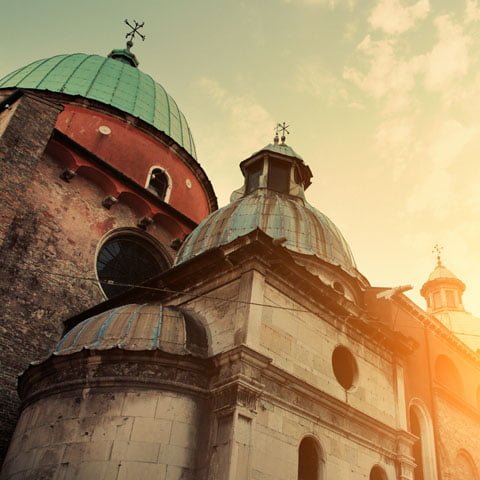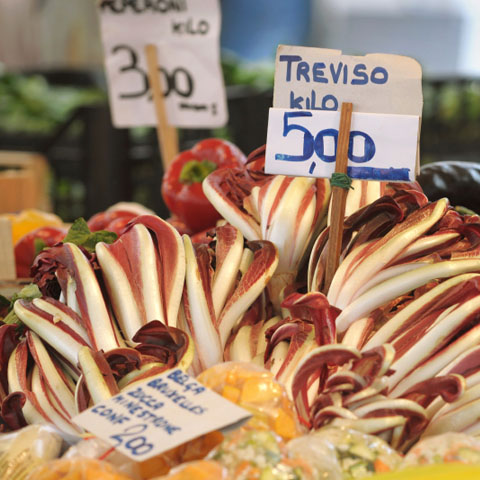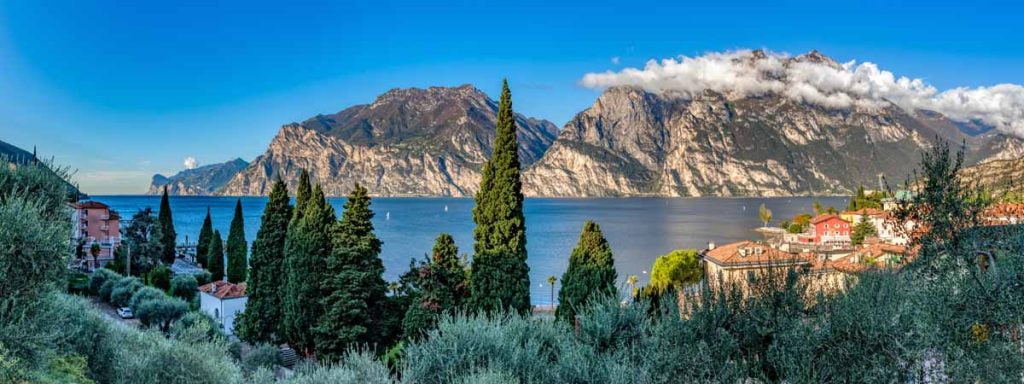Located a mere 20 miles north of the city of Venice in the plains of the present-day Veneto region of Italy lies an undiscovered gem of a city known as Treviso. Home to roughly 80,000 people, Treviso is sometimes known as the gateway to the Veneto region due to its proximity to both Padova and Venice. Indeed, Treviso is a city that, sadly, suffers in obscurity due to its proximity to the much better known and more popular Venice. Despite this, Treviso is a beautiful town with a relaxed atmosphere and more than enough to entertain and entice the visitors that all too often overlook it.
Treviso is a little walled city built of brick and stone nestled between the Sile River and several other tributaries. Like a version of its neighbor Venice in miniature, the town is crisscrossed with small waterways and canals that run through gardens, houses, and street corners. The city features narrow, brickwork streets that wind in mazelike paths through the town and old millstreams, still with their waterwheels intact, though serving little more than a decorative purpose these days. Treviso is in many ways the absolute perfect picture of an old, traditional European small town.
Compared to the more bustling nature of its neighbor, where tourists hustle from attraction to attraction, camera shutters clicking all the way, Treviso is a much more laid back and relaxed place to visit. Many of the stores and restaurants are quainter compared to similar places in tourist-heavy cities like Venice. The serene atmosphere of Treviso has earned it the moniker of “città cortese,” or “the courteous city.”
Of course, like any city with such a long history in Europe, there is no shortage of things to do or see in Treviso. Perhaps its most notable attraction would be the Treviso Cathedral, also known as the Cathedral of San Pietro. This massive cathedral is one of the most distinctive landmarks in the area with its seven domes. The church contains many notable works of art, an ancient catacomb that runs beneath it, and even its own museum – the Museo Diocesano d’Arte Sacra di Treviso.
Visitors to Treviso will also want to make a trip over to the Piazza dei Signori near the center of town. On market days, visitors will find this town square filled to the brim with all sorts of interesting shops and stalls, selling delicious, traditional Italian foods and goods. In this bustling piazza there are also three major palazzi – the Palazzo del Trecento, the Palazzo del Podestà, and the Palazzo Pretorio. The square also opens up into Treviso’s main street, Via Calmaggiore, which is lined with many excellent examples of upscale fifteenth and sixteenth century houses, still well maintained and decorated. For those interested in going back in time to find out more about when Treviso was characterized by feuds between extremely powerful families, the area offers historic castles and towers.
However, in keeping with Treviso’s relaxed atmosphere, perhaps the best thing to do when visiting the city is to merely take a leisurely walk. Visitors can explore the outer walls and gates of Treviso, observing the old military fortifications that kept the city safe in the past. Or, for those more interested in nature, a visit is surely due to the Natural Park of the Sile River, which protects over 10,000 acres of wetlands, forests, meadows, and the river.
GEOGRAPHY & CLIMATE
Treviso lies at a confluence of many different rivers and tributaries. More than six rivers flow through the middle of town, including the Botteniga, the Cagnan, the Buranelli, the Cantarane, the Roggia (also known as the Siletto), and, of course, the largest and most famous river that flows through the town, the Sile. As would be expected of an area with so many waterways, the landscape is humid and a little bit marshy, sometimes referred to as a lagoon landscape.
However, towards the northeast end of the town, the landscape begins to transform. Vineyards and farmland dot the landscape, including the many radicchio fields that the town is famous for, as well as the vineyards that grow the area’s beloved Prosecco wine. Beyond these vineyards and farms lie rolling green hills that eventually extend into large, glacial peaks, such as the Montello peak.
Treviso has a mild, Mediterranean climate with cool winters that only occasionally dip below freezing and warm summers that rarely crest 86 degrees Fahrenheit. The rainfall is mostly consistent year-round, with the rainiest month being June.
WHEN IN TREVISO
Most visitors to Treviso only spend a brief amount of time in the city before moving onto Venice or Padova. While it is certainly recommended that people who decide to extend their stay in Treviso make a day trip to both of these illustrious cities, it would be a true shame to merely use Treviso as a place to rest one’s head away from the crowds and noise and spend all of their time in these more popular cities. Visitors should not miss out on the small-town charm of Treviso.
Travelers to the city should make an effort to visit the many landmarks that dot Treviso. One of these landmarks is the Church of San Francesco. This church has been greatly abused by conquerors and militaries over the years, and yet it is remarkable just how much of it and its treasure still remains. Visitors can admire a Madonna and Child with Saints painted by Tommaso da Modena, and even the tomb of the son of the famed Dante Alighieri, Pietro Alighieri.
Another church worth visiting in Treviso is the Church of San Nicolò. This church is one of the more interesting examples of architecture found in Treviso, with massively tall, straight walls, round piers, and a vaulted, timber roof. Inside, the church’s altar features a painting known as Madonna Enthroned by fra Marco Pensaben and Girolamo Savoldo. But perhaps the most interesting works of art in the Chiesa di San Nicolò are the frescoes found in the chapterhouse of the former monastery. Here, over 40 frescoes by Tommaso da Modena wrap around the room, and the detail and liveliness of the paintings of the monks at their desks and going about their duties is impressive even to this day.
All that said, perhaps the most impressive church to be found in Treviso is the Treviso Cathedral, or the Cathedral of San Pietro. With its iconic seven domes, it is undoubtedly the most distinctive structure in the city containing the famed Museo Diocesano and the eleventh century crypt.
Treviso also has several museums that visitors should take the time to see. The Museo Bailo, also known by its full name as the Luigi Bailo Civic Museum, contains a fantastic collection of classic art and archaeology from the area, as well as many contemporary pieces spanning a range of diverse art styles from Impressionism to avant-garde. Visitors to Treviso should also check out the Museo Civico di Santa Caterina, which contains even more frescoes by Tommaso da Modena, including perhaps his most famous work, The Life of St. Ursula. In addition, there are many other paintings featured here as well, including paintings by Giovanni Bellini, Pisanello, Lorenzo Lotto, and many other artists.
Treviso also features a famous fish market known as the Pescheria. This fish market rests on a small island in the middle of a confluence of rivers and is surrounded by historic buildings and sculptures of mermaids and other fish. This bustling market is one of the most atmospheric sites in Treviso, but for those who do not favor fish then a trip to the Piazza dei Signori is in order. Translating to English as the “Gentlemen’s Square,” on market days this square is bustling with dozens upon dozens of stalls, selling traditional Italian foods, ingredients, and wares. The square is also surrounded by three different palazzi, and opens up onto the town’s main street, which is lined with beautiful fifteenth and sixteenth century Italian houses.
However, despite everything there is to see and do in Treviso, perhaps the best thing to do in town that keeps in line with the atmosphere is to simply take a leisurely walk around the gates and walls of the city, or in the local Natural Park of the Sile River. For those that would prefer to explore the old urban areas of the ancient town, some highlights include the Porta San Tommaso and Porta Santi Quaranta gatehouses, which separate the old city in the center from the more modern sections of the city around the edges of town. For the nature lovers, highlights of the natural park include the many small ponds, marshes, forests, and springs that dot the surrounding landscape.
Often overshadowed by neighboring Venice, the cultural city of Treviso is well worth a visit in its own right. Travelers who spend time in Treviso will be rewarded with stunning medieval and Renaissance frescoes as well as the breathtaking architecture of the Treviso Cathedral and the tranquil atmosphere of this city positioned at the confluence of several rivers.
Travel Guides
The Veneto Region of Italy
The Cities of Veneto, Italy








